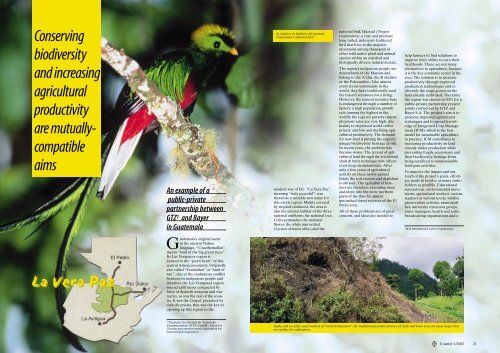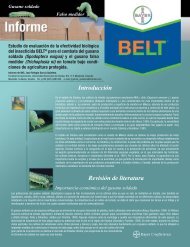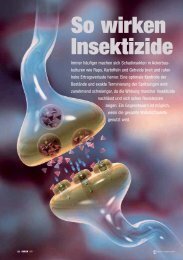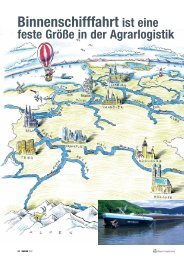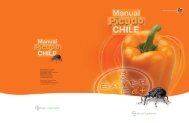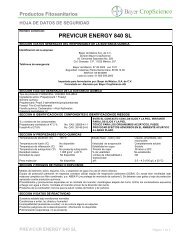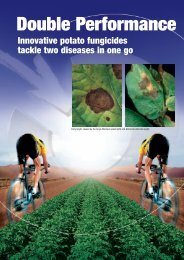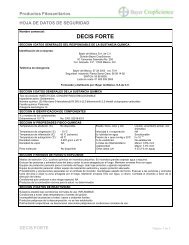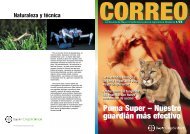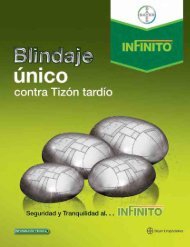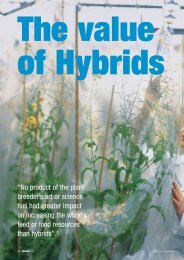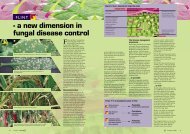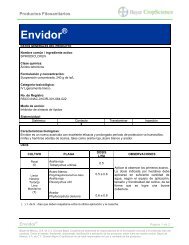Download: ( 403 KB pdf) - Bayer CropScience Mexico
Download: ( 403 KB pdf) - Bayer CropScience Mexico
Download: ( 403 KB pdf) - Bayer CropScience Mexico
Create successful ePaper yourself
Turn your PDF publications into a flip-book with our unique Google optimized e-Paper software.
A typical peasant farm in the region.Progress: now farmers' wives attend class too.This class on integrated pest management isteaching farmers the use and benefits of theyellow plastic traps for harmful insects.Education in the farming community isgradually introducing the AgroVida conceptinto secondary schools as well.relegated to housekeeping, care ofsmall children, fetching the dailywater supply for the household, etc.The project is deliberately trying tobreak those social barriers and toempower women by encouragingtheir participation in the trainingsessions. Children and youth participationis also very important,because their level of education isoften higher than those of otherfamily members. They are usuallyable to read and write and are goodconveyors of knowledge to theirparents. Young children are alsomore likely to accept – and adoptfor the long-term – behaviouralchanges.Educational material has beenadapted to the communitiesinvolved (the level of literacy isonly about 42% among the ruralpopulation). It includes: flip charts(with posters), films, slide shows,computer presentations, workbooks,educational comic-strips, historytales and teaching modules.Audio-visual tools are the mosteffective materials used and all ofthe training is made very dynamicand participatory, especiallythrough the use of demonstrationplots in the “model” farmers’ fields,where the training often takesplace.The project capitalises on experiencesgained in similar projects –generically known as “Agrovida”.The original pilot project was initiatedin Brazil in 1995 and similarprojects have since spread withinthe country and beyond, to otherLatin American countries such asColumbia and Chile (see CourierAgrochem 2/98). In Guatemala, theproject includes a broader focus(it is planned to place strongeremphasis on improving soil andwater management techniques, cropdiversification, market developmentfor agricultural produce etc.), whichcan only be obtained through “burdensharing” via the public-privateapproach taken. ■locally-based ILO 2 group workingfor the abolishment of child labourhave all indicated their interest inparticipating. To date, 15 differentorganisations and entities havejoined the project on an “in kind”contribution basis, mainly throughtraining, and all share their expertiseand experience to realise benefitsfor the rural community.Some 30,000 smallholders and theirfamilies work about 30,000 ha ofagricultural land. Almost 60% ofthem are involved in subsistencefarming. Their yields are very lowdue to the unsustainable use of thenatural resources and the lack ofadequate agricultural tools andtechniques. Their earnings areamong the lowest in the country,and need to come both from theirown crops and from labour on otherfarms. The main crops grown arecorn and beans and vegetables. 20%of the farmers grow tomato, pepper,cucumber, onion, peanut, potato,broccoli and cauliflower. However,tomato, once the driving crop interms of earnings, has now lost itsstatus due to pest infestations andlack of knowledge of how to dealwith the problem. The 20% betterofffarmers are those growingexport crops such as cardamom,orchids, leather leaf and other ornamentalplants, and coffee (althoughthe latter is now also suffering fromthe low commodity prices).Tomato production has thereforebeen a first major target for theproject. Due to the presence ofwhitefly, a virus vector, the tomatoproduction area has declined in thelast few years. Newly-developedconcepts in Integrated PestManagement (IPM) for whiteflycontrol are re-opening productionareas that had been abandoned formany years because of the spread ofvirus disease. Mechanical pestcontrol measures such as the use ofyellow plastic traps, and trap-crops(beans) to control early whiteflyinfestations favour this pest’snatural enemies and predators.Crop protection products are usedin a very targeted and efficientmanner: “as much as needed but aslittle as possible”. Targeted usereduces spending on crop protectionproducts and contributes tosavings for the farmers, so economyand ecology go together.Because appropriate humannutrition is also a concern, theproject focuses on the high-proteinpeanut crop, in order to improvethe population’s diet. Impressiveresults have already been obtained.Using traditional methods of peanutproduction (degenerated local varieties,no supplementary plant nutrition,no pest and disease control,etc.) farmers were obtaining nomore than 975 kg/ha. New cultivationtechniques (improved varieties,healthy seeds, integrated plantnutrition including both organicmatter usage and mineral fertilisers,appropriate pest and diseasecontrol, etc.) improved yields tomore than 3,500 kg/ha. Net earningsincreased from US$ 730/ha to US$2,200/ha. This is a very importantstep towards increasing farmers’income and improving their dailydiet in terms of both quantity andquality.The programme employs fourpromoters, who are assignedspecific tasks in chosen communitiesand villages, one supervisor, twoassociated counselling directors,one accountant, and 50 trainers. Allof the trainers speak the main localnative language k´ekchíe, and havehad from 8 to 15 years experience inother agricultural developmentprojects. Prior to the launch of thecurrent project, they receivedproper training in a seminar(“sustainability related to agriculture”)divided into various teachingmodules relating to ICM: croprotation, natural resources (e.g. soiland water) management, conservationtillage, integrated plant nutrition,crop timing and IPM. The lastof these integrates all of the availablepest, disease and weed controlmeasures (mechanical, biologicaland chemical) into an optimisedpackage. To keep all of the trainersupdated, the training activities aremaintained during the project.The plan is to reach 3,000 “modelfarmers” and their families, including6,000 children, through the 50trainers. The programme intends toreach and actively include all familymembers according to their personalinterests and activities. Traditionally,women’s participation intraining and working activities hasbeen very small in this region,because they have usually been22Courier 1/2002


